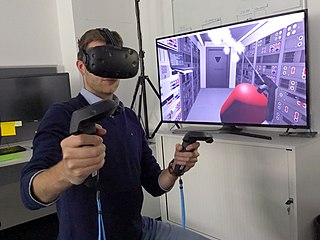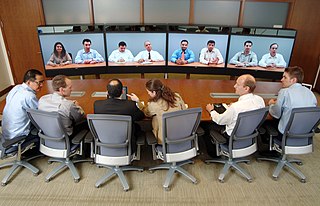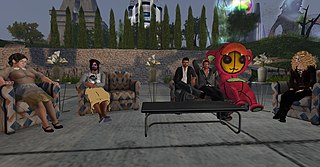
Virtual reality (VR) is a simulated experience that employs 3D near-eye displays and pose tracking to give the user an immersive feel of a virtual world. Applications of virtual reality include entertainment, education and business. VR is one of the key technologies in the reality-virtuality continuum. As such, it is different from other digital visualization solutions, such as augmented virtuality and augmented reality.
Computer-assisted language learning (CALL), known as computer-aided instruction (CAI) in British English and computer-aided language instruction (CALI) in American English, Levy briefly defines it as "the exploration and study of computer applications in language teaching and learning." CALL embraces a wide range of information and communications technology "applications and approaches to teaching and learning foreign languages, ranging from the traditional drill-and-practice programs that characterized CALL in the 1960s and 1970s to more recent manifestations of CALL, such as those utilized virtual learning environment and Web-based distance learning. It also extends to the use of corpora and concordancers, interactive whiteboards, computer-mediated communication (CMC), language learning in virtual worlds, and mobile-assisted language learning (MALL).

Telepresence is the appearance or sensation of a person being present at a place other than their true location, via telerobotics or video.

Second Life is a multiplayer virtual world that allows people to create an avatar for themselves and then interact with other users and user-created content within a multi-user online environment. Developed for personal computers and owned by the San Francisco-based firm Linden Lab, it launched on June 23, 2003 and saw rapid growth for some years; in 2013 it had approximately one million regular users. Growth eventually stabilized, and by the end of 2017, the active user count had fallen to "between 800,000 and 900,000". In many ways, Second Life is similar to massively multiplayer online role-playing video games; nevertheless, Linden Lab is emphatic that their creation is not a game: "There is no manufactured conflict, no set objective."
A virtual environment is a networked application that allows a user to interact with both the computing environment and the work of other users. Email, chat, and web-based document sharing applications are all examples of virtual environments. Simply put, it is a networked common operating space. Once the fidelity of the virtual environment is such that it "creates a psychological state in which the individual perceives himself or herself as existing within the virtual environment" then the virtual environment (VE) has progressed into the realm of immersive virtual environments (IVEs).

A virtual world is a computer-simulated environment which may be populated by many simultaneous users who can create a personal avatar and independently explore the virtual world, participate in its activities, and communicate with others. These avatars can be textual, graphical representations, or live video avatars with auditory and touch sensations. Virtual worlds are closely related to mirror worlds.

In computing, an avatar is a graphical representation of a user, the user's character, or persona. Avatars can be two-dimensional icons in Internet forums and other online communities, where they are also known as profile pictures, userpics, or formerly picons. Alternatively, an avatar can take the form of a three-dimensional model, as used in online worlds and video games, or an imaginary character with no graphical appearance, as in text-based games or worlds such as MUDs.

The metaverse is a loosely defined term referring to virtual worlds in which users represented by avatars interact, usually in 3D and focused on social and economic connection.

An interactive whiteboard (IWB), also known as interactive board, interactive display, interactive digital board or smart board, is a large interactive display board in the form factor of a whiteboard. It can either be a standalone touchscreen computer used independently to perform tasks and operations, or a connectable apparatus used as a touchpad to control computers from a projector. They are touch screen enabled small computers. They are used in a variety of settings, including classrooms at all levels of education, in corporate board rooms and work groups, in training rooms for professional sports coaching, in broadcasting studios, and others.
Technology integration is defined as the use of technology to enhance and support the educational environment. Technology integration in the classroom can also support classroom instruction by creating opportunities for students to complete assignments on the computer rather than with normal pencil and paper. In a larger sense, technology integration can also refer to the use of an integration platform and application programming interface (API) in the management of a school, to integrate disparate SaaS applications, databases, and programs used by an educational institution so that their data can be shared in real-time across all systems on campus, thus supporting students' education by improving data quality and access for faculty and staff.
"Curriculum integration with the use of technology involves the infusion of technology as a tool to enhance the learning in a content area or multidisciplinary setting... Effective technology integration is achieved when students can select technology tools to help them obtain information on time, analyze and synthesize it, and present it professionally to an authentic audience. Technology should become an integral part of how the classroom functions—as accessible as all other classroom tools. The focus in each lesson or unit is the curriculum outcome, not the technology."

77 Million Paintings is a digital art software/DVD combination by British musician Brian Eno, released in 2006.
Annabeth is a female English given name created from a combination of the names Anna and Elizabeth. As it is a combination of two names, it has a combined meaning, which is favor, 'full of grace', and 'my God is an oath'.

CitySpace was an internet-based virtual world launched at SIGGRAPH 1993 by educator and project director Zane Vella. CitySpace was one of the earliest online virtual 3D environments and first came to attention via mainstream news media in late 1993. CitySpace was also the first user-generated virtual world, similar to virtual worlds like Second Life, and enabled participants to contribute 3D computer graphics and digital imagery to a collaborative real-time rendered 3D virtual world in which participants interacted with each other via avatars. CitySpace was active from 1993-1996 and won the 1996 NII Award for Arts and Entertainment.
Cyberformance refers to live theatrical performances in which remote participants are enabled to work together in real time through the medium of the internet, employing technologies such as chat applications or purpose-built, multiuser, real-time collaborative software. Cyberformance is also known as online performance, networked performance, telematic performance, and digital theatre; there is as yet no consensus on which term should be preferred, but cyberformance has the advantage of compactness. For example, it is commonly employed by users of the UpStage platform to designate a special type of Performance art activity taking place in a cyber-artistic environment.
Arts in Second Life is an artistic area of a 3D social network that has served, since 2003, as a platform for various artistic pursuits and exhibitions.
Second Life is used as a platform for education by many institutions, such as colleges, universities, libraries and government entities.
Virtual reality (VR) is a computer application which allows users to experience immersive, three dimensional visual and audio simulations. According to Pinho (2004), virtual reality is characterized by immersion in the 3D world, interaction with virtual objects, and involvement in exploring the virtual environment. The feasibility of the virtual reality in education has been debated due to several obstacles such as affordability of VR software and hardware. The psychological effects of virtual reality are also a negative consideration. However, recent technological progress has made VR more viable and promise new learning models and styles for students. These facets of virtual reality have found applications within the primary education sphere in enhancing student learning, increasing engagement, and creating new opportunities for addressing learning preferences.

A virtual reality game or VR game is a video game played on virtual reality (VR) hardware. Most VR games are based on player immersion, typically through a head-mounted display unit or headset with stereoscopic displays and one or more controllers.

VRChat is an online virtual world platform created by Graham Gaylor and Jesse Joudrey and operated by VRChat, Inc. The platform allows users to interact with others with user-created 3D avatars and worlds. VRChat is designed primarily for use with virtual reality headsets, being available for Microsoft Windows PCs and as an app for Android-based headsets such as the Meta Quest, Pico 4, and HTC Vive XR Elite. VRChat is also playable without a virtual reality device in a "desktop" mode designed for a mouse and keyboard, gamepad, or mobile app for touchscreen devices.

Meta Horizon Worlds is an online virtual reality game with an integrated game creation system developed and published by Meta Platforms. On this multi-player virtual platform, players move and interact with each other in various worlds that host events, games, and social activities. They can also build and publish worlds similar to Rec Room. Horizon Worlds works on Oculus Rift S, Meta Quest 2, Meta Quest Pro and Meta Quest 3 headsets.











